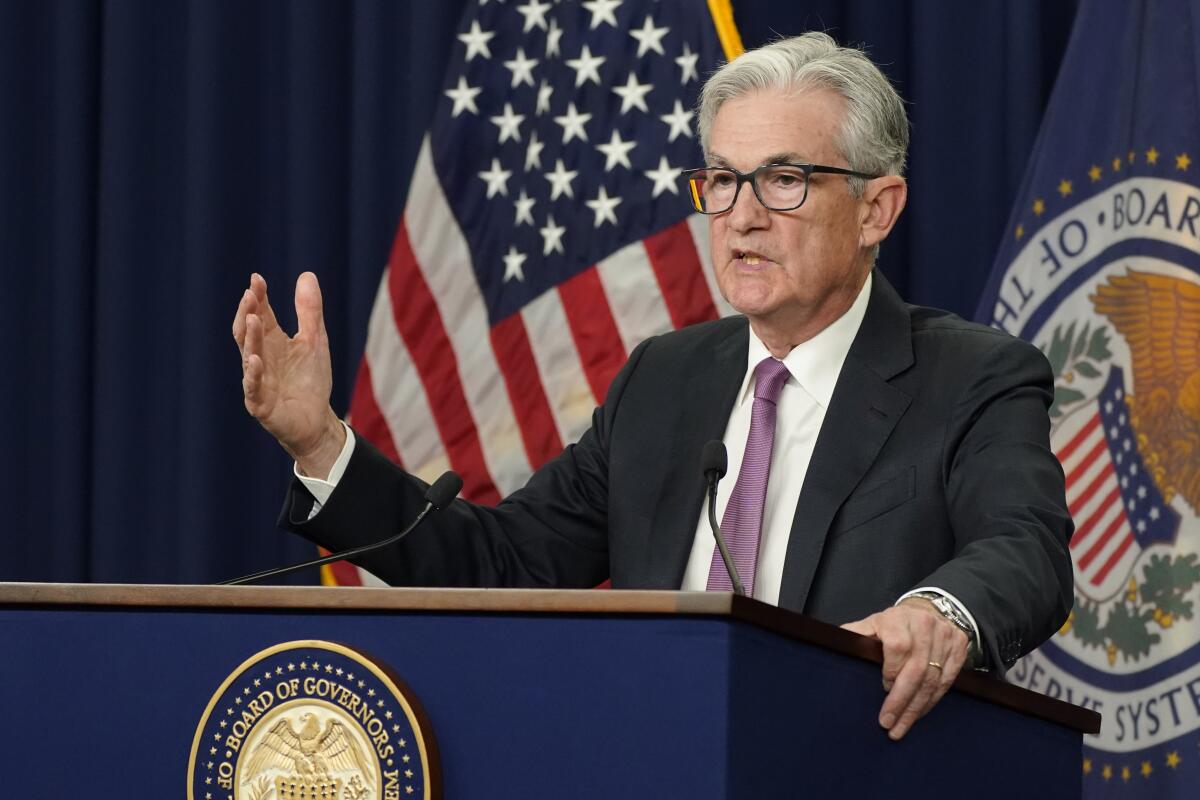With mortgage rates above 6%, here’s what the Fed’s latest hike could mean

- Share via
It’s bad enough that home prices in Southern California remain high despite cooling demand, averaging almost seven times the state’s median income for a family of four.
Making matters worse, though, is the rapid rise in mortgage interest rates. The rate for a 30-year, fixed-interest mortgage has doubled in nine months, topping 6% last week for the first time since George W. Bush’s presidency.
That’s painful not just for people trying to borrow money to buy a home, but also for homeowners with adjustable-rate mortgages, whose monthly payments ratchet up every year that interest rates rise.
Two factors in the increase have been inflation and the Federal Reserve Board of Governors’ efforts to tame it. The Fed has raised the short-term federal funds rate (the interest that banks charge one another for overnight loans) five times this year, including Wednesday.
David Wilcox, senior economist at the Peterson Institute for International Economics and at Bloomberg Economics, said a key factor in mortgage interest rates is how much inflation lenders expect to see over the life of the loan. And given the messaging from the Fed and the continued inflationary pressures in the economy, financial markets are expecting a higher trajectory for interest rates in the coming years than they did earlier in 2022.
So should you expect to pay even more for a new mortgage now that the Fed has imposed its latest increase? Possibly, but there’s no simple cause-and-effect here. Instead, the Fed’s moves affect mortgage rates indirectly by influencing the expectations of lenders and financial markets.
Economically speaking, the vibes are off. Here’s what you should be doing with your money, according to financial experts.
Consider what happened after the Fed raised its target interest rate by 0.75 percentage points in June, the largest increase since 1980: Mortgage rates fell. They started climbing again a few weeks later in anticipation of the Fed’s meeting in July, when it raised its target by 0.75 percentage points for the second time. And after that, mortgage interest rates fell again.
This illustrates how financial markets run ahead of the Fed, reacting to expectations rather than waiting for the central bank to act. And when the Fed meets those expectations, “you typically see some kind of relief rally,” said Robert Heck, vice president of mortgage at Morty, an online mortgage broker.
The Fed is trying to break the economy’s inflationary fever without pushing the country into a recession, but the usual indicators of economic health are confusingly jumbled. Gross domestic product is slumping, but unemployment remains low; corporate profits are largely solid; consumer confidence is recovering; and consumer spending continues to grow, albeit slowly.
Fed Chairman Jerome H. Powell has repeatedly said that the Fed would raise interest rates until inflation was under control. Nevertheless, some lenders and investors looked at the economy in July and thought the Fed would take its foot off the monetary brakes, Heck said.
That changed in August, however, when Powell and other Fed officials reiterated their determination to, as Powell put it on Aug. 26, “keep at it until we are confident the job is done.” Deliberately or not, the statement echoed the title of the memoirs of former Fed Chair Paul Volcker, who used high interest rates to lead the U.S. out of double-digit inflation in the 1980s.
“I think the Fed has succeeded in communicating more clearly, and the market has taken on more, and more thoroughly, their determination to fight inflation and win the battle,” Wilcox said.
A new state-run program, the Forgivable Equity Builder Loan, helps low-income first-time home buyers in California with their down payments.
At the same time, Wilcox said, “the market has concluded that the Fed is going to have to do more to win that fight.”
Recent data show inflation to be broader and more stubborn than previously believed, and the labor market continues to be “extraordinarily robust,” he said.
Nor did any of the newly released economic data point to interest rates going lower, Heck said.
Hence the steady rise in mortgage interest rates since early August.
One more reason for the increase, Heck said, was the speculation that the Fed might raise the federal funds rate by an even larger amount Wednesday — 1 to 1.25 percentage points. “I do think that this meeting is probably the one that we’ve been least prepared for, in terms of knowing what’s going to happen,” Heck said. But the Fed met expectations Wednesday, not the speculations.
A no-BS guide to buying your first home in Southern California.
One key to the market’s reaction will be the “dot plot,” or the chart showing how much Fed officials expect the federal funds rate to increase or decrease in the next few years. Powell has said that he expects the federal funds rate to reach 3.4% by the end of this year. After Wednesday’s action, most Fed officials expect the federal funds rate to reach a range of 4.25% to 4.5%. (Going into Wednesday’s meeting, the rate was in a range of 2.25% to 2.5%.)
Another important consideration, Heck said, is what Fed officials said about the central bank’s holdings of mortgage-backed securities. Earlier in the year, the Fed announced that it would pare those holdings by about $35 billion a month, starting this month. The Fed indicated Wednesday that it would stick to that plan. Reducing its holdings even further could have led to higher interest rates through the internal logic of the credit markets.
About The Times Utility Journalism Team
This article is from The Times’ Utility Journalism Team. Our mission is to be essential to the lives of Southern Californians by publishing information that solves problems, answers questions and helps with decision making. We serve audiences in and around Los Angeles — including current Times subscribers and diverse communities that haven’t historically had their needs met by our coverage.
How can we be useful to you and your community? Email utility (at) latimes.com or one of our journalists: Jon Healey, Ada Tseng, Jessica Roy and Karen Garcia.
More to Read
Sign up for Essential California
The most important California stories and recommendations in your inbox every morning.
You may occasionally receive promotional content from the Los Angeles Times.










